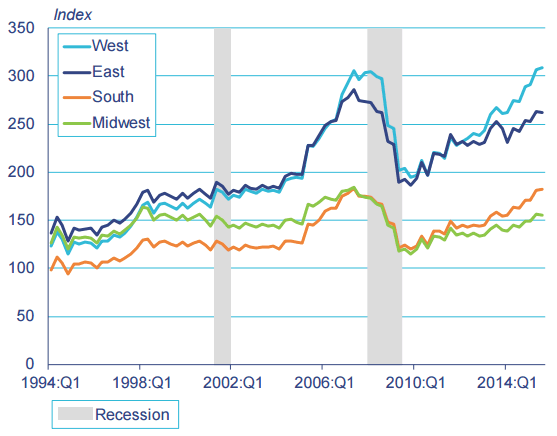Press Release
Commercial Real Estate Debt Sitting on Humpty’s Fence
with Leveraged Loans, Junk Bonds, Sub-Prime Auto Loans...
November 2015
Nov. 11, 2015 (EIRNS)—Another Wall Street debt bubble, that in commercial real estate debt and its derivatives, is showing signs of deteriorating.
San Francisco-based economics author Wolf Richter pointed today to a speech by Boston Federal Reserve President Eric Rosengren citing overheating in the U.S. commercial real estate sector. The $2.5 trillion commercial real estate debt in the United States has grown by 4% in 2015 so far; but much more significantly, the $300 billion in securitization of this debt (CMBS, or commercial mortgage-backed securities) has grown by 20% this year. In the New York commercial estate market, securitization has exploded by 47% this year.
Richter cited two notable signs. First, the Fitch Ratings Agency has just reported
"weakening loan characteristics, declining underwriting quality, and concerns about originator, banker, and rating agency competition.... CMBS cannot afford a repeat of the 2008-2009 experience."
Neither can the American population.
Second, the price index of commercial real estate has shot up in 2015 to where it is 20% higher than the peak in 2007 before the global financial crash.
NCREIF Commercial Real Estate Transactions-Based Real Price Indices
1994:Q1- 2015:Q3  View larger size From "Assessing the Economy's Progress", by Eric S. Rosengren, President of the Federal Reserve Bank of Boston.
Note: Series are adjusted for inflation using the GDP Deflator. Source: National Council of Real Estate Investment Fiduciaries (NCREIF), BEA, NBER, Haver Analytics |
The U.S. commercial real estate and CMBS bubble is more than matched in explosiveness by that of Canada. The national economy there is officially in recession after another contraction of GDP in the third quarter. Its financial system is significantly more concentrated in assets to the oil and gas sector, than is Wall Street. The center of the oil sector is Calgary, Alberta; and there home prices are now falling, unemployment is rising, and 16% (and rising) of the urban area’s total commercial real estate space is empty, according to Bloomberg Nov. 11. Already back in February, the data firm CanOils found that fewer than 10 of the leading 50 Canadian oil and gas companies would be able to sustain their operations long-term with oil at $50 per barrel. It has been below $50 since then and a total of nine Canadian oil drilling and oilfield service firms have already gone under.
